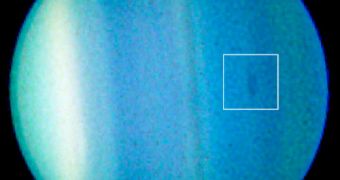One of the things that have always fascinated astronomers about Uranus, the seventh planet from the Sun, is the fact that its axis of rotation is tilted sideways, to a large extent. In fact, it nearly reaches the plane of its revolution around the star, which is something unique to the ice giant. After the planet started being investigated, experts reported that the tilt might have been caused by a collision, and this explanation has remained the accepted one in the international scientific community for many years. Now, a new idea says that this might have not been the case, Technology Review reports.
The thing about the previous theories that always bugged some experts was the fact that, even though the axis of the ice giant was tilted to 97 degrees in regards to the plane of the solar system, the axes of its rings were not. At the same times, the same tilt is exhibited by Uranus' many moons. Additionally, conventional wisdom has it that, if all planets were formed from the same protoplanetary disk revolving around a very young star, then they should all revolve around the star in the same way. French experts Gwenael Boue and Jacques Laskarm, both from the Observatoire de Paris, have a new explanation.
The idea the team proposes is a lot more complicated than the collision hypothesis. They say that, in the early days of the solar systems, planets were migrating all over the place, far away from the orbits we know them to be on today. The team adds that, if the planet had been formed from the get-go with a tilt of as little as 17 degrees, then it could have had its rate of precession increased by one of its moons. The only requirement was for the celestial body to be at least 0.01 Uranian mass, and 50 Uranian radii. The tricky thing about this theory is, of course, the fact that the ice giant doesn't have such a large moon. According to the experts, it may be that it was removed from the planet's orbit by a close encounter.
This encounter may have occurred towards the end of Uranus' migration period, stabilizing the giant body in the configuration we are familiar with today. In order to test their ideas, the researchers ran computer simulations of planetary migrations in the early solar system about 10,000 times. A large number of scenarios were then removed, because they either brought the planet too close to other ones, or on incorrect final positions around the Sun, and so on. Instances in which the moon Oberon, the largest one around the planet today, was ripped from orbit or obliterated were also removed.
This left the experts with the grand total of 17 simulations to go on. They added the theoretical moon to the computations, and then ran each of the scenarios about 100 times. In 37 of the cases, the proposed moon “helped” Uranus get on its side, and, in one of them, the celestial body was removed from orbit following a close encounter with another gas giant. This is not the first time Science proposes that Uranus must have had another moon. Naturally, explaining two mysteries at once is not a small feat. It remains to be seen if future studies will lend more credence to this idea.

 14 DAY TRIAL //
14 DAY TRIAL //